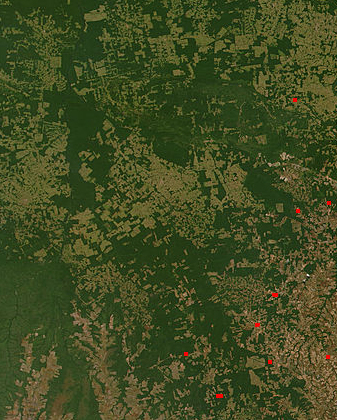By Katrina Marland

It has been an odd week of ups and downs. For instance, NASA released new satellite images showing that coal pollution has been drastically reduced in recent years; but then an international research team showed us that global carbon emissions have gone up 49 percent since 1990. It’s not uncommon to find such highs and lows in the realm of environmental news lately and, hold on tight, because the roller coaster continues — in the Amazon.
On Tuesday, Brazil’s National Institute for Space Research (INPE) finished its estimate of Amazon deforestation from 2010 through 2011 — like NASA, they use satellite images to determine this — and announced that the iconic rainforest is enjoying its lowest deforestation rate in decades. Granted, the Amazon still lost about 2,400 square miles of rainforest between August 2010 and June 2011, but even that amount is 11 percent lower than the previous year. In fact, it is the lowest amount recorded since 1988, when INPE first began these annual estimates. The deforestation rate in the Amazon has been on a steady decline since a spike in 2004 — an encouraging trend that many attribute to Brazil’s longstanding Forest Code, which requires landowners to keep a certain percentage of their land as natural rainforest.
That’s the slow, fun climb to the top of the ride. Ready for the stomach-turning plunge? On the very same day that INPE announced their findings, Brazil’s Senate passed some very controversial (and highly ironic) changes to its Forest Code. Unfortunately, the new revisions also make a number of less-than-desireable changes. If the revisions are approved by Brazil’s lower house and the president and become law, the following will take effect:
- The amount of forest that private landowners are required to protect will be reduced from 80 percent to 50 percent.
- Landowners who violated the law before July 2008 will be granted amnesty and not be required to replant their land to bring it into compliance.
- The margin of required protection along waterways (particularly important for watershed health throughout the Amazon ecosystem) will be reduced from 100 feet to 50 feet.
It’s worth noting that, before these revisions were proposed, Brazil was on track to cut its greenhouse gas emissions by 37 percent by the year 2020, a commitment the nation made in 2009. What impact the new Forest Code will have on that goal, as well as the recently declining deforestation rate, we can only guess at this point, but I think it’s safe to say that it can’t be anything good.